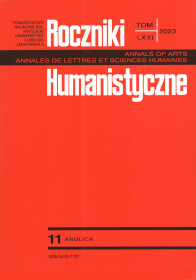Depositing “Strangeness”: Applying the Principles of Detritus to the Narrativization of Cities in N. K. Jemisin’s Short Fiction, “The City Born Great” and “Saints, Sinners, Dragons, and Haints, in the City beneath the Still Waters”
Depositing “Strangeness”: Applying the Principles of Detritus to the Narrativization of Cities in N. K. Jemisin’s Short Fiction, “The City Born Great” and “Saints, Sinners, Dragons, and Haints, in the City beneath the Still Waters”
Author(s): Heather ThaxterSubject(s): Language and Literature Studies, Studies of Literature, American Literature
Published by: Towarzystwo Naukowe KUL & Katolicki Uniwersytet Lubelski Jana Pawła II
Keywords: detritus; cities; liminality; N. K. Jemisin; speculative short fiction
Summary/Abstract: N. K. Jemisin’s speculative short fiction often portrays cities as living entities which are in constant tension with the humans who occupy the same space. In particular, “The City Born Great” and “Saints, Sinners, Dragons, and Haints, in the City Beneath the Still Waters” highlight recurring themes of waste as integral to that interaction. By metaphorically applying the principles of detritus as being critical to system stability, waste becomes essential to a cycle in constant flux between humans and the cityscape. During this process, “[cities] make a weight on the world, a tear in the fabric of reality” (“The City” 20). This liminal space serves as a portal that releases the strangeness deposited in the city by past inhabitants and meshes with present deposits to mould the city’s character.
Journal: Roczniki Humanistyczne
- Issue Year: 71/2023
- Issue No: 11
- Page Range: 75-87
- Page Count: 13
- Language: English

